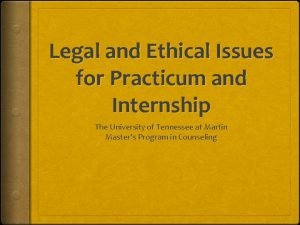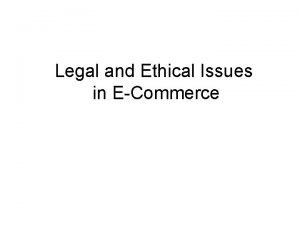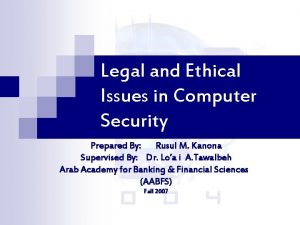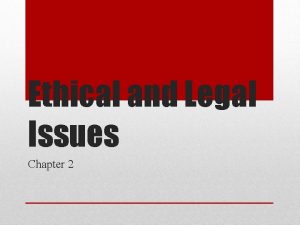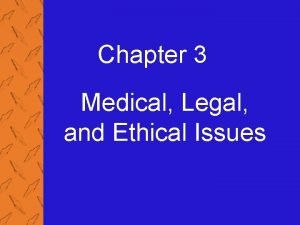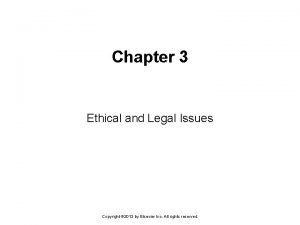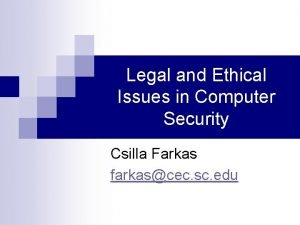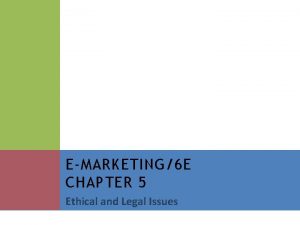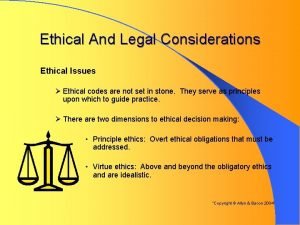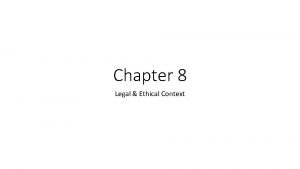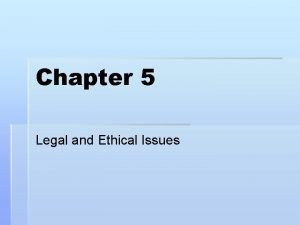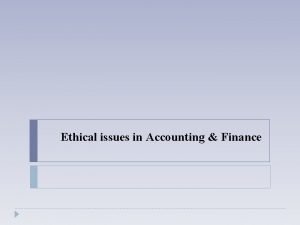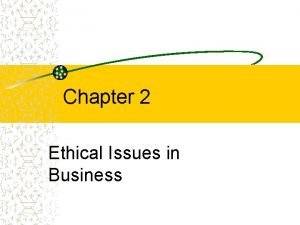Legal and Ethical Issues for Practicum and Internship












- Slides: 12

Legal and Ethical Issues for Practicum and Internship The University of Tennessee at Martin Master's Program in Counseling

Objectives of This Training Clarify the legal and ethical responsibilities of students, site supervisors, and university supervisors Outline the common legal and ethical issues of supervision State the best practices involved in resolving legal and ethical issues Affirm the commitment of students, site supervisors and university supervisors to adhere to the legal and ethical standards of professional associations

Professional Affiliations Site supervisors, university supervisors and students are expected to follow the standards of their profession ACA, ASCA, ACES Site supervisors, university supervisors and students have the responsibility to familiarize themselves with these professional standards and to follow them

Professional Insurance All UTM practicum students and interns are required to purchase professional liability insurance Site supervisors are expected to provide their own liability insurance

Common Legal and Ethical Issues of Practicum Students and Interns Informed Consent Confidentiality Reporting of abuse Rights of minors versus the rights of parents

Common Legal and Ethical Issues in Site Supervision Balancing the needs of clients/students with those of the supervisee Maintaining confidentiality of the supervisee Guarding against dual relationships with supervisee Properly training the supervisee to deal with legal and ethical issues

Emergency and Special Circumstances The site supervisor should train the student how to follow proper organizational procedures in the event of an emergency. The site supervisor should directly explain to the student how to proceed should the site supervisor be absent from the facility

ACES Standards for Site Supervisors The supervisor advises the supervisee of the parameters of confidentiality in supervision and acts accordingly. This includes how evaluations of the supervisee may be shared with concurrent and/or future supervisors. The supervisor infuses ethical discussions throughout supervision sessions. The supervisor requires the supervisee to address ethical considerations as part of treatment planning and to document this in case notes The supervisor guides the supervisee’s critical thinking process about various ethical issues that arise in clinical work.

ACES Site Supervisor, cont. The supervisor is knowledgeable of prevalent ethical violations and works toward minimizing them in supervision. The supervisor avoids behaviors that might lead to direct liability (e. g. , failure to meet with the supervisee as scheduled and/or as needed, neglecting important client information that the supervisee shares, assigning clients to supervisees who are inadequately trained to deal with those clients’ concerns) and indirect (vicarious) liability. The supervisor addresses ethical issues as needed and, when necessary, reports ethical breaches to relevant constituents (e. g. , university, agency, certification and/or licensure board) in a timely manner.

ACES, cont. The supervisor understands that client welfare is his/her first and highest responsibility and acts accordingly. The supervisor assigns the supervisee clients who are appropriate to the supervisee’s experience, developmental level, etc. , and/or adjusts supervision (e. g. , frequency, closeness) as needed. If clients are assigned by others, the supervisor provides input regarding appropriate clients (e. g. , number, severity of client issues). The supervisor ensures that supervisees provide clients with professional disclosure statements and written informed consent documents that specify that the supervisee is under supervision and is not licensed or certified, if this is the case, and includes the name and contact information of the supervisor.

ACES, cont. The supervisor does not compromise the supervisory relationship by engaging in relationships with supervisees that are considered inappropriate. The supervisor does not engage in multiple relationships with supervisees nor with supervisees’ significant others. The supervisor attends to power issues with the supervisee to prevent harmful non-sexual and sexual relationships. The supervisor explains to the supervisee the appropriate parameters of addressing the supervisee’s personal issues in supervision (identifies the issue, helps the supervisee the clinical implications, works to minimize the detrimental effects in the supervisee’s clinical work, contributes to a plan for resolution that does not directly involve the supervisor) and acts accordingly.

ACES, cont. The supervisor provides ongoing performance assessment and evaluation of the supervisee, including the supervisee’s strengths and limitations. Early in the relationship, the supervisor outlines how the supervisee will be evaluated, by what standards, and how and when this information will be given to the supervisee as well as to third parties. The supervisor employs methods of direct observation of the supervisee’s work with clients. The supervisor provides the supervisee with fair and ongoing performance assessments and evaluations, including the supervisee’s strengths and limitations. The supervisor assesses the supervisee for impairment, blind spots, and other limitations.
 Professional and ethical issues during internship
Professional and ethical issues during internship Ethical media issues
Ethical media issues Legal ethical and professional aspects of security
Legal ethical and professional aspects of security Legal and ethical issues in use of ict
Legal and ethical issues in use of ict Legal ethical and taxation issues in e business
Legal ethical and taxation issues in e business Legal and ethical issues in computer security
Legal and ethical issues in computer security Chapter 2 ethical and legal issues
Chapter 2 ethical and legal issues Chapter 3 medical legal and ethical issues
Chapter 3 medical legal and ethical issues Chapter 3 ethical and legal issues
Chapter 3 ethical and legal issues Attack sophistication vs intruder technical knowledge
Attack sophistication vs intruder technical knowledge Legal and ethical issues chapter 5
Legal and ethical issues chapter 5 Legal and ethical issues chapter 3
Legal and ethical issues chapter 3 Chapter 6 legal and ethical issues
Chapter 6 legal and ethical issues
